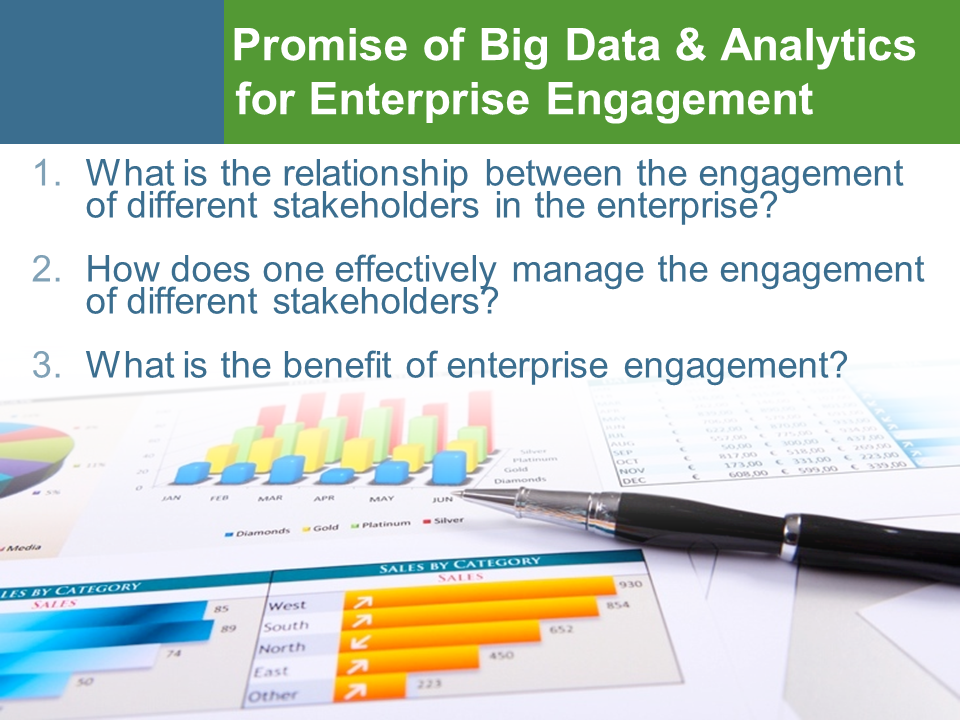Baruch College Professor Sees Big Promise for Analytics in Enterprise Engagement
 Few people in academia better understand the convergence of analytics and Enterprise Engagement than Charles Scherbaum, Associate Professor of Psychology at Baruch College and a member of the doctoral faculty at the Graduate Center of the City University of New York. Scherbaum, an early contributor to the Enterprise Engagement Alliance curriculum on analytics and a consultant to Rideau, a leading recognition and rewards solution provider, is known for his work on applying analytics to help drive human behavior to achieve concrete objectives. He was also recently a speaker at Engagement University in Orlando, produced by the Enterprise Engagement Alliance.
Few people in academia better understand the convergence of analytics and Enterprise Engagement than Charles Scherbaum, Associate Professor of Psychology at Baruch College and a member of the doctoral faculty at the Graduate Center of the City University of New York. Scherbaum, an early contributor to the Enterprise Engagement Alliance curriculum on analytics and a consultant to Rideau, a leading recognition and rewards solution provider, is known for his work on applying analytics to help drive human behavior to achieve concrete objectives. He was also recently a speaker at Engagement University in Orlando, produced by the Enterprise Engagement Alliance.
While Scherbaum admits that there’s some hype around analytics, he believes the attention is warranted due to the ability to make better decisions around a broad range of human capital investments, including both enterprise-wide and specific engagement initiatives, to achieve tactical sales, marketing and human resources goals and objectives.
“The entire conversation of human capital, big data and analytics is getting a lot of attention right now,” he notes, “but, ironically, the revolution began back in the 1990s. The concept of a balanced scorecard in business or using credit scores to evaluate creditworthiness and similar platforms have been around for a while.” For years, says Scherbaum, consumer marketers have used analytics to target coupons and other marketing; sports teams use it to make all sorts of decisions related to players and positions; and casinos use it to make decisions as to the right time for casino staff to make personal contact when a high roller is winning or losing.
What’s New
What’s new, Scherbaum emphasizes, is the type of data available and the ability to link it all together to make better decisions. At one time in the human capital arena, “all you could do was measure such things as performance and engagement ratings – a pretty limited set of data,” he says. “Now when we think about the digital world, we have all sorts of data – social network activity, Internet usage, Internet traffic, call-center or CRM (customer relationship management), etc. We can mine comments people leave on social media sites and emails for qualitative analysis and look at that against the data.”
Another other new ingredient, says Scherbaum, is the ability to better apply predictive analytics and other tools to make better decisions. Predictive analytics can assess the relationship variables to better predict outcomes of specific initiatives going forward, providing the basis for running different “what-if” scenarios.
He explains that analytics can help an organization gain a competitive advantage by understanding four things:
- How the strategic objectives of the organization are being met and driving performance.
- The value chain (e.g., service-profit chain or the way people add value to a process or transaction.)
- How to solve the business problems of the organization.
- Where to direct what type of action.
Imagine, he says, what can be done in a call center: “We now have the ability to link customer service representatives and outcomes with specific customers. We can track all sorts of interactions and outcomes that were never before possible, and even link that to such information as employee attendance, education, pay, geographic location, etc.”
All of this information, Scherbaum says, can help specifically identify the types of characteristics and skills call center employees need in order to succeed. “Do employees identified as ‘engaged’ in surveys handle calls more quickly, or handle more per day?” he asks. “How often do they disconnect headphones to take breaks and how does that affect overall results?” The answers aren’t always what one expects. Properly rested call center employees might in some cases be more productive in terms of actual call quality and outcomes (i.e., less need for escalation).
Scherbaum notes that one of the key benefits of analytics is to provide the basis for fact-based decisions. He has seen many occasions when analytics didn’t support assumptions and which, in turn, helped build a consensus on how to move forward. “Executives are comfortable with dashboards now,” he says. “What’s new is the ability to gain insights from that information to help make better decisions.”
 Analytics and Enterprise Engagement
Analytics and Enterprise Engagement
So what can human capital analytics do in the world of Enterprise Engagement? The immediate benefits, says Scherbaum, come in the form of “the metrics organizations can use to track progress and support or justify decision-making and measure impact and effectiveness – specifically, how an activity, policy, practice or event impacts and important outcome.”
He believes that analytics can help answer the following key questions:
- What is the relationship between the engagement of different stakeholders in the enterprise?
- How does one effectively manage the engagement of different stakeholders?
- What are the actual benefits of Enterprise Engagement?
To answer these questions, says Scherbaum, “one has to articulate the enterprise’s engagement value chain, the various stakeholders and the role that they play.” What’s needed is “a shared definition of engagement and what it looks like for various stakeholders in relation to the desired outcomes. The organization has to have answers to questions like: Why are we undertaking this? What could undermine the effort? It has to make sure it has the ability to develop a strategy to ensure that the analytics yield the desired information, a method obtaining the necessary data and a general appetite for the undertaking so that it’s not undermined by politics.”
Once an organization decides to move forward, practical considerations include the means of capturing and analyzing data; having the resources and talent to do so (either outsourced or internal); the specific technology tools to accomplish the effort; and experts with the business insights necessary to help communicate and interpret the data for practical use.
Analytics can also be used for the purpose of designing better human capital initiatives. For instance, says Scherbaum, in the field of recognition analytics “lets you measure to what degree your efforts influence change or affect employee behavior. Just like an onboarding, training and leadership coaching are supposed to have outcomes, so does recognition. Analytics can give us some clear answers as to the degree to which we do that, as well as measure the return-on-investment of those behaviors.”
Scherbaum recommends starting small, focusing on a specific initiative, such as measuring the impact of a recognition or other tactical program for which there is adequate data. Many smaller companies or divisions of larger firms sometimes think they lack data, when in fact with payroll records today and other sources of CRM, sales and web data, there’s a lot more than meets the eye. “Sometimes, you need to crawl before you walk,” he says. “You can take one or two definable issues and monitor the data for a while to see what takes shape.”
Despite his enthusiasm for the power of analytics, Scherbaum notes that organizations have to be wary of its limitations. For example, he says he wouldn’t encourage more consumption of wine to fight crime based on data showing a clear correlation between wine-drinking and lower crime, since other factors could likely come into play.
Understand the Limitations
“For each situation, one needs to know what can or cannot be done,” he explains. “People have to be realistic when talking about predicting something. Sometimes we don’t have enough data to make an educated prediction. One needs to be able to step back, be realistic, with the competence to draw insights. It involves a team effort of I.T., analysts and management at the front lines.” When looking for an analytics expert, the key is to find people or companies not only with extensive training and experience in analytics, but also in business and technology.
One question that many people have about human capital analytics is privacy. When linking data from a variety of sources, it can have a “big brother” feel to some and raise concerns about a loss of privacy. In the context of Enterprise Engagement, privacy is a complicated and evolving issue. Much of the data that could be used for analytics in the context of Enterprise Engagement is already collected and combined as part of normal business operations. In some sense, analytics applied to these data are nothing new. However, it is the insights about specific stakeholders, partners, managers or employees (e.g., which employees are likely to leave the enterprise) that have raised concern.
The issue is complicated by the fact that the data often used in these types of analytics come from the European Union (EU). The EU has a number of directives that guide the use of personally identifiable information from EU citizens and the transfer of these data out of the EU. Recently, the EU High Court nullified a treaty between the EU and U.S. that provided a framework for transferring and working with EU data in the U.S. The broad outlines of a new treaty have been established, but the specific details are still in negotiation. This will be a developing area that can impact the global application of analytics in the Enterprise Engagement space.
Content Sponsor: Rideau Recognition Solutions
Contact: Jennifer Lumba, CRP
Tel. 877-789-0449, ext. 378
Rideau.com














